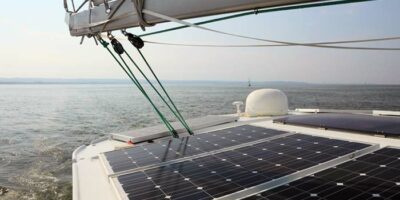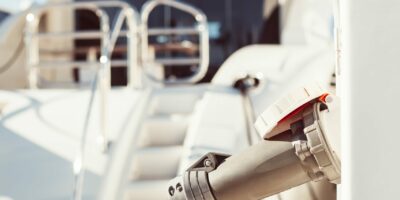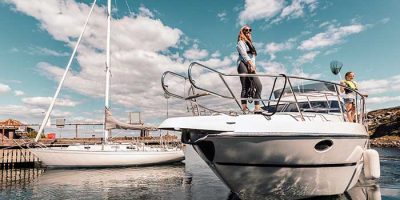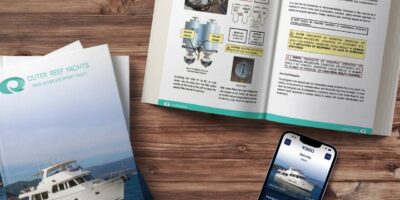Barnacles in Your Seastrainer? There’s A Simple Solution For That
Marine growth on your boat's AC unit can be fixed with simple, environmentally-friendly cleaning & prevention tips.
- April 5, 2024
In This Article:
- Address corrosion concerns & marine growth.
- Prevent marine growth in the seastrainer.
- Use more environmentally friendly ways to clean your seastrainer.
Imagine yourself on your boat. It’s a hot summer day and you are enjoying the cool air conditioning in the salon while looking out at the beautiful view of the water. Suddenly, it gets much hotter in your boat. It’s not just you though, it’s your AC unit breaking down due to marine growth and barnacles clogging up the raw water conduit that carries seawater to the equipment to keep it cool. Marine growth is a common problem, with simple fixes, but you much remain proactive in order to prevent further issues, such as your AC unit breaking down. Now how do you fix this issue and prevent it from happening again?
Addressing Corrosion Concerns & Marine Growth In Your Seastrainer
After docking, you open your seastrainer and find that it is corroded and filled with algae and barnacles. What do you do now? First, manually remove the barnacles and debris. You can utilize a soft brush or scraper to ensure effective cleaning without causing damage to the strainer material. Next, you can use acid-based cleaners to dissolve the marine growth. Please ensure to use acid-based cleaners specifically designed for marine environments and follow the guidelines on the packaging for your safety. If needed, call a professional cleaning service. This is particularly helpful for persistent growth or large vessels. These experts use environmentally friendly practices, capturing debris to prevent it from entering the water and ensuring the sea strainer remains in optimal condition. Professional services are particularly valuable for maintaining the integrity of sea strainers in challenging marine environments.
When it comes to addressing the corrosion on your seastrainer, it starts with the material your seastrainer is made from. Choosing the right materials is crucial in preventing corrosion. If possible, opt for seastrainers made from corrosion-resistant materials such as stainless steel, bronze, or suitable marine alloys. Just this step alone will reduce the risk of corrosion significantly. To further reduce the risk, you can apply corrosion-resistant coatings and corrosion inhibitors to your seastrainers, adding another layer of defense. This extra barrier adds longevity to the stainer’s lifespan. Of course, after addressing the corrosion, it is good to keep regular cleaning practices to prevent any future corrosion. Frequent cleaning also addresses marine growth, further aiding in the maintenance process.
Preventing Marine Growth In The Seastrainer
The easiest way to prevent marine growth on your AC unit is to complete regular checks. Either visual inspections or adding it to your biweekly or monthly checklist will help prevent overgrowth of anything you don’t want in your seastrainer. When completing regular checks, it is also good to complete regular cleanings, and keep your boat moving. Studies show that barnacles and other organisms are less likely to attach themselves to a moving vessel.
When it comes to the seastrainer itself, you can use specific products in order to make it harder for organisms to grow on the strainer. ElectroSea is a has great products when it comes to preventing marine growth and corrosion in your seastrainer. Their product, ElectroStrainer, stops marine growth within the seastrainer itself through updated technology. Please note, we are not sponsored by ElectroSea, we are simply recommending it through our own employees experience with the product.
There are also multiple techniques you can use to prevent growth yourself. First, applying antifouling coatings will stop marine growth as it creates a protective barrier on the strainer, making it more difficult for growth to occur. Next, install zinc anodes on your sea strainer. These sacrificial anodes help prevent corrosion and can deter marine growth. Regularly inspect and replace zinc anodes as needed to ensure continuous protection. You can also use biocide treatments to inhibit the growth of barnacles and other marine organisms. These treatments can be applied to the sea strainer according to the manufacturer’s recommendations. Ensure that the chosen biocide is suitable for your sea strainer material and complies with local regulations.
Staying Environmentally Friendly
Using cleaning your strainer and pipes can be very environmentally taxing, if you are not using the right products. When manually removing barnacles, capture the debris in a containment system to prevent it from entering the water, and then dispose of the collected material properly on land. When it comes to acid-based cleaners, make sure they are specifically for marine use. Prioritizing biodegradable barnacle removers also helps minimize the impact on marine ecosystems. Ensure that the chosen products comply with environmental regulations. Finally, refrain from using harsh chemicals that can harm marine life. Select cleaning agents with minimal ecological impact and verify their compatibility with the surrounding environment.
Saving Your AC Unit From Disrepair
Maintaining the health and functionality of your boat’s AC unit requires a proactive and comprehensive approach to address both corrosion concerns and marine growth in the pipes and sea strainer. Regular checks, cleanings, and choosing corrosion-resistant materials for the sea strainer are essential steps in preventing breakdowns. Utilizing professional cleaning services can be beneficial, especially in challenging marine environments. Taking preventive measures, such as applying antifouling coatings, installing zinc anodes, and using biocide treatments, adds an extra layer of defense against marine growth and corrosion.
Environmental responsibility is crucial in these maintenance practices. Proper disposal of debris, choosing biodegradable barnacle removers, and selecting cleaning agents with minimal ecological impact contribute to the sustainability of marine ecosystems. By incorporating these practices into your boat maintenance routine, you not only extend the lifespan of your AC unit but also contribute to the preservation of the environment. Ultimately, a combination of proactive maintenance, thoughtful material choices, and environmentally friendly practices will ensure a trouble-free and sustainable boating experience.
About Vessel Vanguard
Vessel Vanguard is a leading marine safety and maintenance management software provider dedicated to revolutionizing the maritime industry. With a commitment to innovation and excellence, Vessel Vanguard delivers cutting-edge solutions to streamline operations and enhance vessel performance and safety.
Latest Industry Insights

Embracing E-Boating Efficiencies

Boat Fuel Systems

The Future of Boats & Boating

Yacht Navigation Light Inspection
View All of Our Industry Insights
Navigate maritime with the latest news, practical how-to guides, insightful analyses and more.
